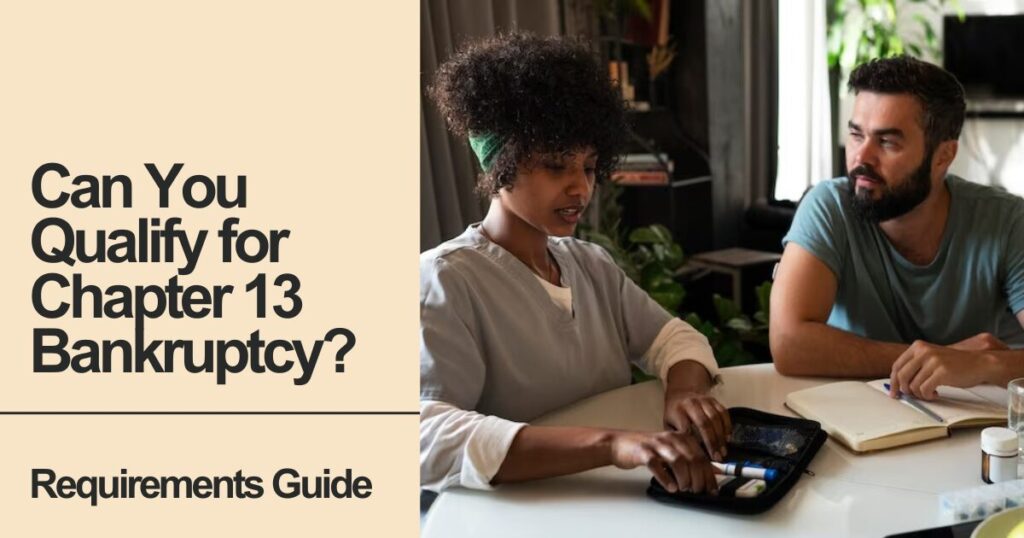
Chapter 13 bankruptcy allows individuals with regular income to restructure debt through a 3-5 year repayment plan. To qualify, your secured debts must not exceed $1,580,125 and unsecured debts must stay below $526,700. You need steady income, completed credit counseling, current tax filings for four years, and no recent bankruptcy dismissals within 180 days.
Your mortgage is three months behind. Collection calls won’t stop. The foreclosure notice arrived last week. You’re wondering if Chapter 13 bankruptcy can help you keep your home and get back on track.
Chapter 13 bankruptcy, often called a wage earner’s plan, lets you reorganize debt while keeping your assets. But not everyone qualifies. Understanding the eligibility requirements helps you determine if this path makes sense for your situation.
This guide breaks down exactly what you need to qualify for Chapter 13, how debt limits work, and what steps you’ll take to file successfully.
Who Can File for Chapter 13 Bankruptcy?
Chapter 13 bankruptcy is designed specifically for individuals and married couples with regular income. This bankruptcy chapter isn’t available to everyone.
Only individuals, sole proprietors, and married couples filing jointly can pursue Chapter 13. If you run a business as a sole proprietor, you can include both personal and business debts in your filing. However, corporations, partnerships, and other business entities cannot file Chapter 13.
Your income source doesn’t have to be traditional employment. Regular income includes wages, Social Security benefits, pension payments, alimony, disability benefits, or any other consistent income stream. Even if you’re unemployed but your spouse works, you can file jointly and use their income to support your repayment plan.
The key requirement is consistency. You need to demonstrate that your income will continue throughout the 3-5 year repayment period. Without steady income, you won’t be able to make the required monthly payments to your bankruptcy trustee.
Understanding the Debt Limits That Determine Eligibility
For cases filed between April 1, 2025, and March 31, 2028, your secured debts cannot exceed $1,580,125 and unsecured debts must stay below $526,700. These limits adjust every three years to account for inflation.
What counts as secured debt? Any loan where you’ve pledged property as collateral. Your mortgage, car loans, and property with tax liens all fall into this category. If you don’t pay, the lender can take the property.
Unsecured debts include credit card balances, medical bills, personal loans, back utility bills, and legal fees. These creditors can’t seize specific property if you default, though they can sue you or damage your credit.
Here’s where it gets tricky: some debts have both secured and unsecured portions. If your car is worth $15,000 but you owe $20,000, you have $15,000 in secured debt and $5,000 in unsecured debt. These classifications matter when calculating whether you meet the debt limits.
If your debts exceed these limits, you’ll need to consider Chapter 11 bankruptcy instead, which has no debt ceiling but involves more complex procedures and higher costs.
People Also Love to Read This: Who Handles Your Case When Tragedy Strikes? Understanding Wrongful Death Representation
Mandatory Requirements Before You File
Several non-negotiable requirements exist before you can file Chapter 13. Missing even one can derail your case.
Credit Counseling Completion
You must complete a credit counseling course from an approved nonprofit agency within 180 days before filing. This session typically lasts 60-90 minutes and can be done online, by phone, or in person. You’ll receive a certificate proving completion, which must be filed with your bankruptcy petition.
The counseling helps you understand alternatives to bankruptcy and may help you develop a preliminary debt management plan. Without this certificate, the court won’t accept your filing.
Tax Filing Compliance
You must provide proof that you’ve filed federal and state income tax returns for the previous four years. This means if you’re filing in November 2025, you need returns from 2021, 2022, 2023, and 2024.
You’ll also need to give your bankruptcy trustee a copy of your most recent tax return at least seven days before your first meeting of creditors. If you’ve fallen behind on tax filings, catch up before initiating bankruptcy proceedings.
Previous Bankruptcy Restrictions
You cannot file Chapter 13 if you had a bankruptcy case dismissed in the previous 180 days for willful failure to appear in court or comply with court orders. Additionally, you cannot receive another Chapter 13 discharge if you received one within the past two years, or a Chapter 7 discharge within the past four years.
These waiting periods prevent abuse of the bankruptcy system and ensure debtors take the process seriously.
Income Requirements and the Disposable Income Test
Unlike Chapter 7, Chapter 13 doesn’t have an income ceiling. However, you need enough income to fund your repayment plan while covering basic living expenses.
If your current monthly income falls below your state’s median, your repayment plan will typically last three years unless the court approves a longer period. If your income exceeds the state median, you’ll generally need a five-year plan.
Your disposable income determines how much you’ll pay unsecured creditors. This is calculated by subtracting reasonable living expenses and secured debt payments from your monthly income. The court examines your budget carefully to ensure you’re not spending excessively while creditors receive minimal payment.
Priority debts like recent taxes, child support, and alimony must be paid in full through your plan. Secured debts require you to stay current on regular payments while catching up on arrears. Whatever remains goes to unsecured creditors, who may receive anywhere from 1% to 100% of what they’re owed.
The Chapter 13 Repayment Plan Requirements
Your repayment plan must pay off all required debts, and you must earn enough to implement the plan. The bankruptcy trustee and court review your proposed plan to ensure it’s feasible and treats creditors fairly.
Your plan must be proposed in good faith, meaning you’re genuinely attempting to repay creditors rather than abuse the system. It must provide for full payment of arrears on secured debts unless you’re surrendering the property. You also need to commit all your disposable income to the plan.
In no case may a plan provide for payments over a period longer than five years. You’ll typically start making payments within 30 days of filing, even before the court officially confirms your plan.
If you fall behind on plan payments, the trustee can file a motion to dismiss your case. At that point, you’ll need to catch up quickly or risk losing bankruptcy protection entirely.
Why People Choose Chapter 13 Over Chapter 7
Several situations make Chapter 13 the better option, even though Chapter 7 is simpler and faster.
If your income exceeds the Chapter 7 means test maximum, you won’t qualify for Chapter 7 but can still file Chapter 13. This makes Chapter 13 the only bankruptcy option for higher-income earners.
If you’ve fallen behind on your mortgage or car payments, Chapter 13 allows you to catch up on arrears over three to five years while keeping the property. Chapter 7 doesn’t provide this catch-up mechanism, so foreclosure or repossession would proceed.
If you own nonexempt property that would be sold in Chapter 7, Chapter 13 lets you keep it by paying creditors its value through your plan. This protects assets like second vehicles, valuable collections, or vacation property.
Chapter 13 also offers a broader discharge than Chapter 7. Certain debts that survive Chapter 7, like some tax obligations and marital settlement debts, can be discharged after completing a Chapter 13 plan.
Common Mistakes That Disqualify Filers
Understanding what disqualifies you helps avoid costly errors.
Exceeding debt limits is the most common disqualification. If you’re close to the limits, carefully classify each debt as secured or unsecured. Sometimes paying down certain debts before filing makes sense, though timing matters to avoid preferential transfer issues.
Failing to complete credit counseling or obtain the certificate before filing causes immediate rejection. Don’t assume you can complete it after filing—the law requires it beforehand.
Missing tax returns from any of the previous four years creates problems. If you haven’t filed, work with a tax professional to get current before pursuing bankruptcy. The court won’t accept “I’ll file them later” as an excuse.
Having insufficient income to fund even a minimal plan leads to denial. If your income barely covers living expenses, you won’t have disposable income for creditors. In this case, Chapter 7 might be more appropriate if you qualify.
People Also Love to Read This: When Should You Hire a Truck Accident Lawyer?
Steps to Determine Your Eligibility
Start with a comprehensive financial assessment. List all your debts and classify them as secured or unsecured. Calculate the totals to see if you’re within the statutory limits.
Gather your income documentation from the past six months. This includes pay stubs, bank statements showing deposits, Social Security award letters, pension statements, and any other income sources. Calculate your average monthly income.
Review your tax filing history. Locate returns for the past four years, or make arrangements to file any missing returns immediately.
Consider consulting a bankruptcy attorney before filing. Chapter 13 is complex, and skipping a step or improperly filling out a form can lead to your case being thrown out or not having certain debts covered. Attorneys help you navigate the requirements, prepare accurate paperwork, and propose a confirmable plan.
Many bankruptcy attorneys offer free initial consultations. Use this opportunity to discuss your specific situation and determine whether Chapter 13 is your best option.
What Happens After You Qualify and File?
When you file Chapter 13, an impartial trustee is appointed to administer your case. This trustee reviews your petition, collects your monthly payments, and distributes them to creditors according to your plan.
You’ll attend a meeting of creditors about a month after filing. The trustee asks questions about your financial situation, assets, income, expenses, and debts. Creditors can attend but rarely do. Most meetings last less than 10 minutes.
The court holds a confirmation hearing where a judge reviews your repayment plan. If approved, you’ll begin making regular monthly payments. Many courts allow or require payroll deductions to ensure consistent payments.
During the plan period, the law forbids creditors from starting or continuing collection efforts. This automatic stay provides immediate relief from lawsuits, wage garnishments, foreclosures, and harassing phone calls.
Successfully completing your plan leads to a discharge of remaining eligible debts. However, about half of Chapter 13 cases filed are discharged after completing repayment plans, with failure to make plan payments being the most common reason for dismissal.
Conclusion
Chapter 13 bankruptcy offers a structured path to financial recovery for individuals with regular income who want to keep their property while addressing debt. Meeting the eligibility requirements—staying within debt limits, maintaining steady income, completing credit counseling, and keeping current on tax filings—determines whether this option works for you.
The process demands commitment. You’ll make monthly payments for three to five years while living on a strict budget. But successfully completing your plan results in debt discharge and a fresh financial start. If you’re facing foreclosure, falling behind on important debts, or need time to reorganize your finances, Chapter 13 might provide the solution you need.
Frequently Asked Questions
Can I file Chapter 13 if I’m self-employed?
Yes, self-employed individuals and sole proprietors can file Chapter 13 as long as they meet all eligibility requirements. You’ll include both personal and business debts in your filing. Your income must be regular and sufficient to fund your repayment plan. Many self-employed filers successfully complete Chapter 13 while continuing to operate their businesses throughout the 3-5 year plan period.
What happens if my income changes during my Chapter 13 plan?
If your income decreases significantly due to job loss, medical issues, or other circumstances beyond your control, you can request a plan modification or ask the court for a hardship discharge. If your income increases substantially, the trustee may require you to increase plan payments. Always notify your attorney and the trustee promptly when your financial situation changes, as transparency is crucial for maintaining your bankruptcy protection.
How does Chapter 13 affect my spouse if only I file?
If you file individually, your spouse isn’t directly affected by the bankruptcy. However, your spouse’s income will be considered when calculating your household income and disposable income for the repayment plan. Joint debts you share with your spouse won’t be discharged for your spouse—creditors can still pursue them for payment unless they also file bankruptcy. Many couples file jointly when both have significant debts to address all obligations in one plan.



